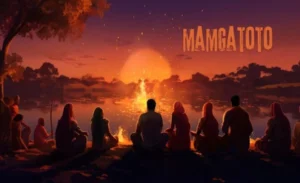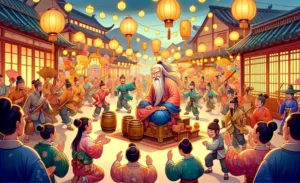Information
Mamgatoto: A Journey Through Tradition and Spirituality

Mamgatoto, a term steeped in cultural significance, represents more than just a practice or location—it is a profound tapestry woven with threads of tradition, spirituality, and communal connection. In exploring the essence of Mamgatoto, one uncovers not only the vibrant practices of a people but also their deeply rooted values and beliefs. This journey through the lens of Mamgatoto offers a glimpse into the soul of a community, highlighting their rituals, stories, and the shared heritage that binds them together.
The Origins of Mamgatoto
The roots of Mamgatoto lie deep within the cultural soil of its people, a heritage passed down through countless generations. It is believed that the concept of Mamgatoto originated as an ancient ritual designed to honor the divine and maintain harmony within the community. Over centuries, it evolved, incorporating elements of mythology, cosmology, and localized traditions unique to the region.
The etymology of Mamgatoto reflects its multifaceted nature. While interpretations may vary, the term often denotes a space or event where the spiritual and the earthly converge. This duality—of the physical and the metaphysical—is a cornerstone of Mamgatoto. It serves as a reminder that life’s essence is not confined to the tangible but extends into realms that require faith and introspection.

The Spiritual Core
At its heart, Mamgatoto is a spiritual journey. It provides a framework for individuals and communities to connect with their higher selves, their ancestors, and the divine. The spiritual practices associated with Mamgatoto often involve meditative rituals, chanting, and offerings. These activities are not just acts of devotion but are deeply symbolic, representing the cyclical nature of existence and the interconnectedness of all beings.
Participants in Mamgatoto often describe a profound sense of peace and clarity that emerges from engaging in these rituals. The repetitive and rhythmic elements, such as the chanting of sacred hymns or the ceremonial dance movements, create a trance-like state, allowing participants to transcend their everyday worries. This state of transcendence is not merely a personal experience but is shared among the community, fostering unity and mutual understanding.
Rituals and Symbolism
The rituals of Mamgatoto are as varied as the communities that practice it. Central to many ceremonies is the use of sacred objects and symbols, each imbued with layers of meaning. For instance, a particular type of vessel might represent abundance, while specific colors used in adornments signify protection or purity.
These rituals are meticulously planned and executed, often involving multiple stages that align with celestial events or agricultural cycles. The timing of Mamgatoto ceremonies is critical, as they are believed to harness the energies of the universe at their peak potency. The preparation for these rituals is a communal affair, with every member contributing in some way—be it through crafting items, cooking traditional meals, or rehearsing the chants and songs that will be performed.
The Role of Storytelling
An integral aspect of Mamgatoto is storytelling. The myths and legends recounted during ceremonies serve not only to entertain but also to educate and inspire. These stories often contain moral lessons, guiding principles, and historical accounts that preserve the community’s heritage.
Storytelling during Mamgatoto is a dynamic and immersive experience. It might involve a storyteller narrating tales while accompanied by music, dance, and visual displays. The audience is encouraged to participate, whether by singing along, clapping to the rhythm, or enacting parts of the story. This interactive approach ensures that the stories resonate with listeners, making the wisdom they impart both accessible and enduring.

Mamgatoto and the Environment
One of the most striking features of Mamgatoto is its inherent respect for the natural world. The ceremonies often take place in outdoor settings, such as forests, riversides, or open plains, chosen for their spiritual significance. These locations are not merely backdrops but active participants in the rituals.
Offerings made during Mamgatoto typically include natural items like fruits, flowers, and grains. This practice underscores the community’s gratitude for nature’s bounty and their recognition of the environment as a sacred entity. Additionally, the rituals often involve acts of environmental stewardship, such as planting trees or cleaning water bodies, reinforcing the community’s commitment to preserving the planet for future generations.
Social and Communal Impact
Mamgatoto is as much a social event as it is a spiritual one. It provides an opportunity for community members to come together, strengthening their bonds and fostering a sense of belonging. The communal meals prepared and shared during these gatherings are a highlight, symbolizing unity and abundance.
In many ways, Mamgatoto acts as a social equalizer. It transcends barriers of age, gender, and socioeconomic status, bringing everyone together under a shared purpose. Elders play a pivotal role, guiding the younger generations and ensuring the continuity of traditions. Their wisdom and experience are revered, and their participation adds depth and authenticity to the ceremonies.
Modern Adaptations
As with many ancient traditions, Mamgatoto has undergone transformations to remain relevant in the modern era. While the core principles remain intact, certain practices have been adapted to fit contemporary lifestyles and sensibilities. For example, digital platforms are now being used to share stories and rituals with a wider audience, ensuring that the essence of Mamgatoto reaches beyond geographic boundaries.
Moreover, eco-conscious adaptations have been introduced, aligning with global efforts to combat environmental degradation. Sustainable materials are used for ceremonial items, and rituals are designed to minimize waste, reflecting a harmonious blend of tradition and modernity.
Key Elements of Mamgatoto Rituals:
- Sacred Symbols: Objects like vessels, candles, and natural offerings represent various spiritual and earthly concepts.
- Chanting and Music: Rhythmic and melodic elements that facilitate meditation and communal harmony.
- Storytelling: Tales that preserve cultural heritage and impart moral values.
- Environmental Acts: Rituals that honor and protect the natural world, such as tree planting and water conservation.
Mamgatoto Participation:
- Spiritual Growth: Deepen your connection with the divine and your inner self.
- Community Building: Strengthen relationships and foster unity among participants.
- Cultural Preservation: Keep traditions alive and relevant for future generations.
- Environmental Awareness: Develop a greater appreciation and respect for nature.
Conclusion
Mamgatoto is more than just a tradition; it is a living, breathing expression of a community’s soul. Through its rich tapestry of rituals, storytelling, and communal activities, it bridges the gap between the past and the present, the spiritual and the earthly. In embracing Mamgatoto, one embarks on a journey of self-discovery, connection, and transformation—a journey that transcends the boundaries of time and space, uniting all who participate in its timeless dance.
Whether experienced as a deeply personal spiritual practice or as a vibrant communal celebration, Mamgatoto continues to inspire and uplift, offering a beacon of hope and wisdom in an ever-changing world.
-

 Fashion10 months ago
Fashion10 months agoLiteroticaTags Explained: Find And Use The Top Tags For 2025
-

 BUSINESS11 months ago
BUSINESS11 months agoWhat is NippyDrive? A Complete Guide to Using NippyDrive
-

 Biography11 months ago
Biography11 months agoCoco Lovelock Bio, Age, Career, Net Worth, Height, Education, Boyfriend & More
-

 Biography11 months ago
Biography11 months agoWho Is Meow Miu? Get to Know the Latest Star in the Spotlight
-

 Fashion10 months ago
Fashion10 months agoWebfreen.com Fashion: Redefining Affordable Luxury
-

 Home Improvement10 months ago
Home Improvement10 months agoValvula Check 32mm Sodimac: Comprehensive Guide
-

 BUSINESS8 months ago
BUSINESS8 months ago9 Packaging Trends You Can’t Afford to Ignore in 2025
-

 TECHNOLOGY8 months ago
TECHNOLOGY8 months agoTransform Text into Stunning Videos: Free Online AI Text-to-Video Generator
